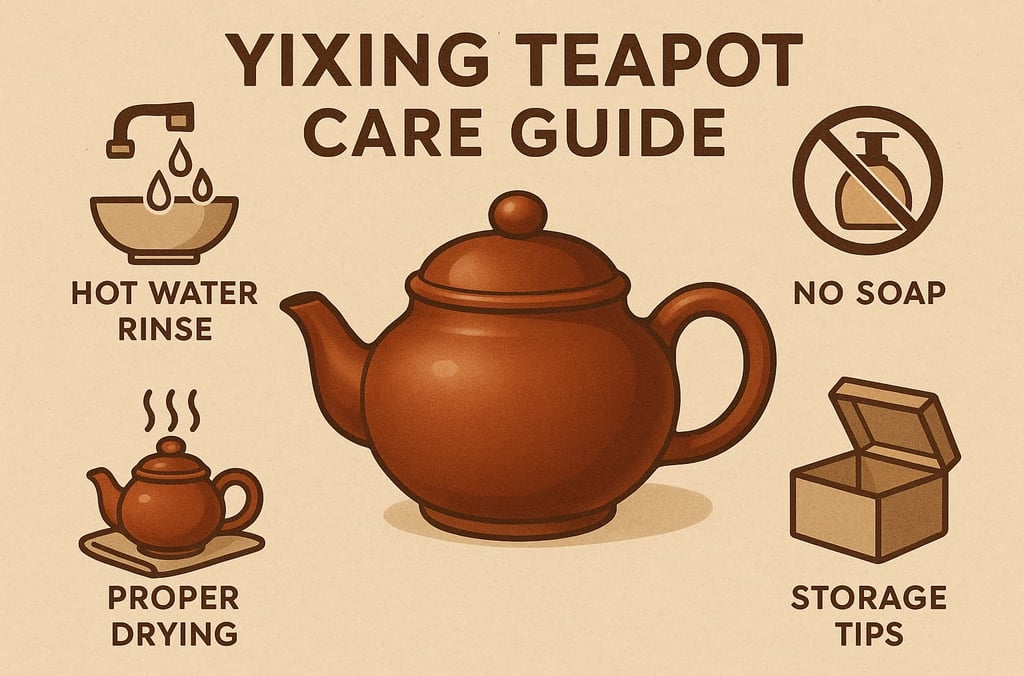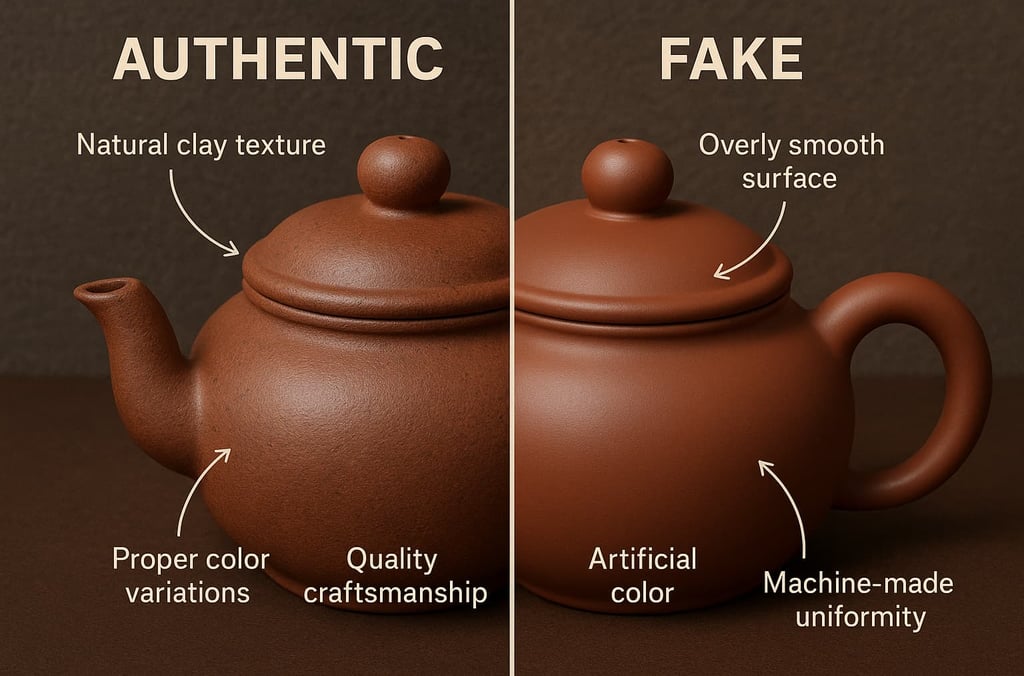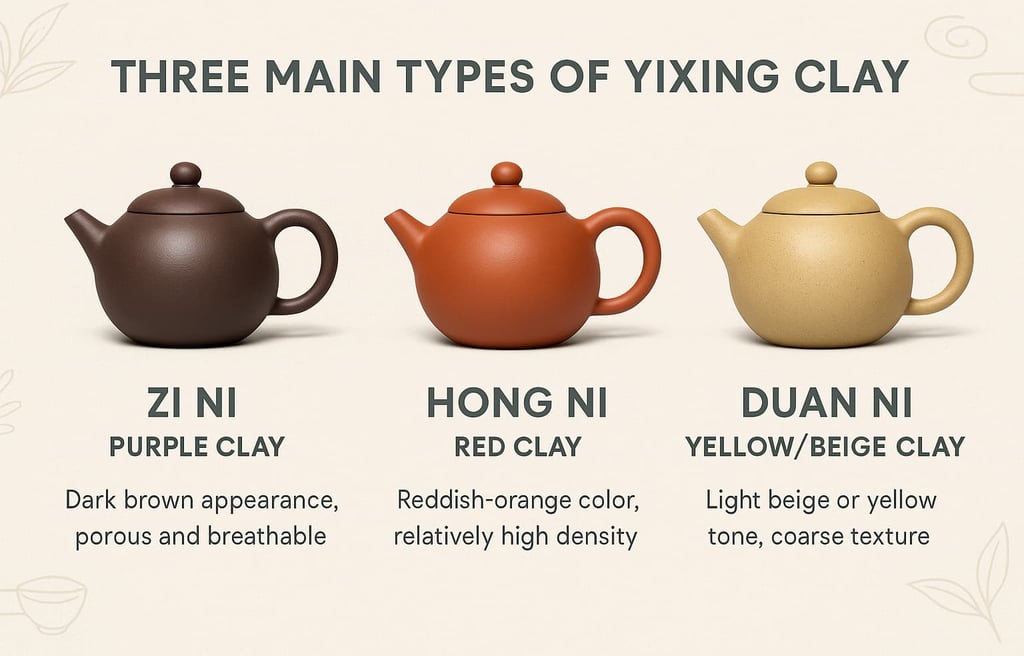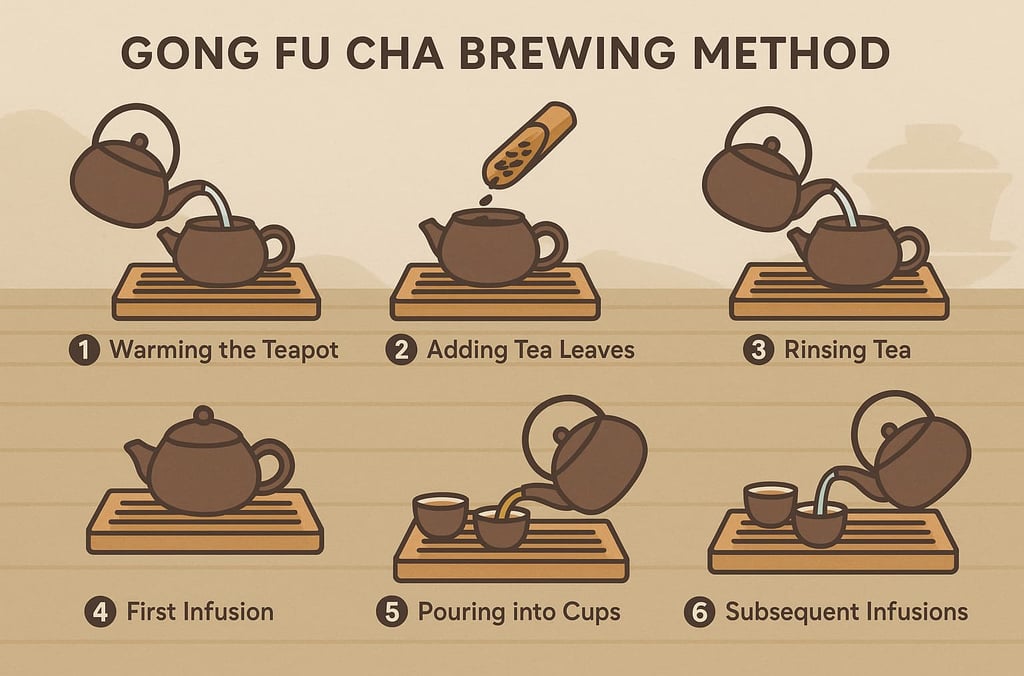How to Choose a Proper Yixing Teapot (2025 Guide)
Master the art of selecting authentic Yixing teapots with our comprehensive 2025 guide. Learn clay types, authentication tips, and brewing techniques from tea experts.
YIXING TEAPOTSEDITOR'S PICKS
TEAPOTARTISAN
10/7/202513 min read


Zi Ni (紫泥): The Classic Choice
Zi Ni represents the most traditional and widely recognized Yixing clay type. Despite its name, authentic Zi Ni ranges from deep reddish-brown to dark purple when fired, depending on the specific mineral content and firing temperature. This clay offers excellent heat retention and moderate porosity, making it incredibly versatile for various tea types.
Best tea pairings: Oolong teas, aged pu-erh, and black teas benefit most from Zi Ni's balanced properties. The clay's neutral characteristics won't overpower delicate flavors while still providing the seasoning benefits that make Yixing teapots special.
Hong Ni (红泥): Bold and Beautiful
Hong Ni creates stunning teapots with rich, warm red tones that deepen beautifully with use. This clay type typically has higher iron content, resulting in slightly different heat retention characteristics compared to Zi Ni. Hong Ni teapots often develop gorgeous patinas more quickly than other clay types.
Ideal applications: Perfect for robust teas like ripe pu-erh, strong black teas, and dark oolongs. The clay's properties complement bold, earthy flavors while adding subtle complexity to the brewing process.
Duan Ni (段泥): The Versatile Option
Duan Ni produces teapots in beautiful beige to pale yellow tones. This clay type offers the highest porosity among the traditional varieties, making it excellent for teas that benefit from maximum breathability during brewing. The lighter color also makes it easier to observe the tea's color during brewing.
Perfect matches: Green teas, white teas, and delicate oolongs shine when brewed in Duan Ni teapots. The high porosity prevents over-extraction while allowing subtle flavors to develop fully.
Mixed Clays and Modern Variations
Contemporary artisans sometimes blend different clay types to create unique properties and appearances. While purists may prefer traditional single-clay teapots, these mixed varieties can offer interesting characteristics for experimental tea drinkers.
Choosing the Right Yixing Teapot for Your Tea
Tea Type Matching Guide
The relationship between clay type and tea variety forms the foundation of successful Yixing teapot selection. This pairing isn't just tradition—it's based on how different clays interact with specific tea compounds to enhance or diminish flavors.
For Pu-erh and Aged Teas:
Zi Ni or Hong Ni work excellently
Higher heat retention helps release complex aged flavors
Clay porosity filters harsh notes while preserving depth
For Oolong Teas:
Zi Ni offers the most versatility across oolong varieties
Duan Ni works well for lighter, more delicate oolongs
Consider teapot size based on your preferred brewing style
For Black Teas:
Hong Ni complements robust black tea flavors
Zi Ni provides excellent balance for daily drinking
Avoid overly porous clays that might over-extract tannins
Size Considerations for Different Brewing Styles
Gong Fu Cha style (traditional Chinese tea ceremony) typically uses smaller teapots ranging from 100-200ml. These sizes allow for multiple quick infusions, gradually extracting different flavor layers from the tea leaves.
Daily drinking might benefit from larger teapots (250-400ml) that can serve multiple people or provide several cups from one brewing session. However, remember that larger teapots require more tea leaves to maintain proper brewing ratios.
Solo sessions work perfectly with tiny teapots (80-150ml) that brew just enough for one or two small cups, allowing you to experience the tea's evolution through multiple infusions.
Shape and Function Relationship
Teapot shape significantly impacts brewing results. Round, bulbous shapes provide maximum space for tea leaves to expand, making them ideal for teas that unfurl dramatically during steeping. Taller, narrower shapes work better for teas that don't expand as much or when you want more controlled extraction.
The spout design affects pouring control and speed. Longer spouts provide better precision for Gong Fu Cha, while shorter spouts offer easier handling for casual brewing. The lid should fit snugly enough to retain heat but not so tightly that it creates vacuum pressure.
Practical Brewing Guide: Maximizing Your Yixing Experience
First Use: Proper Seasoning Techniques
Before brewing your first pot of tea, your new Yixing teapot needs proper preparation. This seasoning process removes any residual clay dust and begins developing the teapot's character.
Step-by-step seasoning process:
Rinse thoroughly with warm water to remove loose clay particles
Fill with hot water and let sit for 10-15 minutes
Empty and repeat 2-3 times until water runs completely clear
Brew weak tea using the type you plan to use regularly
Let tea sit in the teapot for 30 minutes, then discard
Rinse with hot water and dry naturally
🔥 Pro tip: Never use soap or detergent during seasoning or regular cleaning. The clay's porosity will absorb these chemicals, potentially ruining your teapot permanently.
Step-by-Step Gong Fu Cha Method
Traditional Chinese tea culture emphasizes the Gong Fu Cha brewing method, which maximizes your Yixing teapot's potential:
Warm the teapot by filling with hot water, then emptying
Add tea leaves (typically 1/3 to 1/2 of teapot volume)
Rinse the tea with a quick pour of hot water, immediately discarded
First infusion: Pour hot water, steep 30-60 seconds
Pour completely into serving cups or fairness pitcher
Subsequent infusions: Gradually increase steeping time
Continue until tea loses flavor (often 6-10 infusions)
Water Temperature and Timing Guidelines
Different teas require different approaches, but your Yixing teapot's heat retention allows for more forgiving brewing:
Temperature guidelines:
Green/White teas: 175-185°F (80-85°C)
Oolong teas: 195-205°F (90-95°C)
Black/Pu-erh teas: 200-212°F (95-100°C)
Timing flexibility: Yixing's heat retention means you can be less precise with timing than with other brewing methods. The clay naturally regulates extraction, making it harder to over-brew your tea.
Pro Tips for Optimal Results
Temperature control: Pour hot water over the outside of your teapot before brewing to ensure even heat distribution. This traditional technique helps maintain optimal brewing temperature throughout the process.
Leaf-to-water ratio: Start with more tea leaves than you might use in other brewing methods. Yixing's controlled extraction allows for higher ratios without bitterness.
Patience with new teapots: Your teapot will improve with use. The first dozen brewing sessions help establish the clay's seasoning, so don't judge performance too quickly.
Care, Maintenance, and Long-Term Enjoyment


Daily Care Routine
Proper maintenance ensures your Yixing teapot will serve you faithfully for decades while developing increasingly beautiful character. After each use, rinse thoroughly with hot water while the teapot is still warm. This removes tea residue without requiring harsh cleaning methods.
Never use soap, detergent, or abrasive cleaners. The clay's porosity will absorb these chemicals, potentially ruining the teapot's flavor-enhancing properties permanently. Hot water and gentle scrubbing with a soft brush are sufficient for regular cleaning.
Deep Cleaning Guidelines
Occasionally, your teapot may need deeper cleaning, especially if you accidentally brew the wrong tea type or notice off-flavors developing:
Safe deep cleaning method:
Fill teapot with boiling water and let sit overnight
Empty and scrub gently with a soft-bristled brush
Rinse thoroughly multiple times with hot water
Air dry completely before storing
Re-season lightly with your preferred tea if needed
Storage Best Practices
Store your Yixing teapot in a clean, dry location with good air circulation. Avoid sealed containers that might trap moisture and encourage mold growth. Many collectors display their teapots on open shelves where they can be admired while staying properly ventilated.
Climate considerations: Extreme temperature changes can stress the clay, so avoid storing teapots near heating vents, windows with direct sunlight, or areas with significant temperature fluctuations.
Building Your Teapot's Character Over Time
The most rewarding aspect of Yixing teapot ownership is watching your teapot develop character through use. Over months and years, the clay will darken slightly, develop a subtle sheen, and begin contributing its own nuanced flavors to your tea.
Signs of proper aging:
Gradual darkening of the clay's natural color
Development of a subtle, natural sheen
Improved tea flavor and aroma
Smooth, pleasant feel that develops with handling
This patina represents the accumulated history of every tea session, making each well-used teapot unique and irreplaceable.
Buying Guide: Where and How to Purchase
Reputable Sources and Dealers
Finding authentic Yixing teapots requires careful source selection. Established tea shops with knowledgeable staff often provide the best combination of authenticity and customer support. Online retailers like TeapotArtisan specialize in handcrafted Yixing teapots and can provide detailed provenance information.
Questions to ask sellers:
Can you provide information about the clay source?
Who made this teapot, and what is their background?
What firing temperature was used?
Can you guarantee authenticity?
What is your return policy if the teapot proves inauthentic?
Price Range Expectations
Understanding realistic pricing helps avoid both overpriced tourist pieces and suspiciously cheap fakes:
Beginner range ($50-150): Basic authentic pieces from newer artisans or simple designs from established workshops. Perfect for learning and daily use.
Intermediate range ($150-500): Higher quality pieces with better clay, more refined craftsmanship, or work from recognized artisans.
Advanced range ($500+): Master craftsman pieces, rare clay types, or teapots with significant artistic merit. Often considered investment pieces.
Investment vs. Daily Use Considerations
Decide whether you want a Yixing teapot for daily brewing enjoyment or as a collectible investment. Daily-use teapots should prioritize functionality and personal preference over prestige or potential appreciation.
For daily use, prioritize:
Comfortable size for your brewing habits
Clay type that matches your favorite teas
Ergonomic design that feels good in your hands
Reasonable price that won't cause anxiety about regular use
For collecting, consider:
Artist reputation and market recognition
Rarity of clay type or design
Documentation and provenance
Condition and potential for appreciation
Budget Recommendations for Different Experience Levels
Complete beginners: Start with a quality piece in the $75-125 range. This provides authentic experience without overwhelming investment while you learn proper care and brewing techniques.
Developing enthusiasts: Consider pieces in the $150-300 range that offer superior clay quality and craftsmanship. This level provides noticeable improvements in brewing performance.
Serious collectors: Focus on pieces above $300 from recognized artisans. At this level, you're investing in both functional excellence and potential appreciation.
Common Mistakes to Avoid
Purchasing Pitfalls


Many newcomers fall into predictable traps when buying their first Yixing teapot. Avoid buying based solely on appearance—a beautiful teapot made from poor clay will never brew good tea, while a simple, well-made piece will provide years of excellent service.
Don't rush the decision. Take time to research sellers, compare options, and understand what you're purchasing. A hasty decision often leads to buyer's remorse or, worse, purchasing a fake.
Usage Errors
Never use your Yixing teapot for multiple tea types. This fundamental rule prevents flavor contamination and allows proper seasoning development. If you drink various teas, consider multiple teapots rather than one "universal" piece.
Avoid extreme temperature shocks. Don't pour boiling water into a cold teapot or rinse a hot teapot with cold water. Gradual temperature changes prevent thermal stress that could crack the clay.
Maintenance Mistakes
Resist the urge to clean with soap even when the teapot seems dirty. Trust the traditional cleaning methods that have preserved these teapots for centuries.
Don't store a damp teapot. Always ensure complete drying before storage to prevent mold, mildew, or other moisture-related problems.
Cultural Etiquette and Appreciation
Respecting the Tradition
Yixing teapots represent centuries of Chinese artistic and cultural tradition. Approach ownership with respect for the craftspeople who created your teapot and the cultural heritage it represents. This isn't just about brewing tea—it's about participating in a living tradition that connects you to generations of tea lovers.
Sharing the Experience
Consider learning about the cultural context of Chinese tea culture and Gong Fu Cha. Understanding the philosophy behind traditional tea brewing enhances your appreciation and enjoyment of your teapot.
Share your knowledge responsibly. If friends express interest in your teapot, help them understand both the practical aspects and cultural significance. This helps preserve and spread appreciation for authentic craftsmanship.
Seasonal Considerations and Advanced Tips
Climate and Clay Interaction
Your local climate affects how your Yixing teapot performs throughout the year. In humid conditions, the clay's porosity may behave differently than in dry climates. Pay attention to how seasonal changes affect your brewing results and adjust accordingly.
Summer brewing: Higher humidity may require slightly shorter steeping times as the clay retains moisture longer.
Winter brewing: Dry air may necessitate longer warming periods and slightly longer steeping times.
Advanced Brewing Techniques
As you develop expertise with your Yixing teapot, experiment with advanced techniques:
Temperature layering: Start with slightly cooler water for the first infusion, then increase temperature for subsequent brewings to extract different flavor compounds.
Timing variations: Develop your own rhythm based on your teapot's specific characteristics and your taste preferences.
Seasonal tea rotation: Some collectors rotate different teas through the same teapot seasonally, allowing for subtle flavor evolution while maintaining the teapot's primary character.
Troubleshooting Common Issues
When Tea Tastes Off
If your tea suddenly tastes strange, don't panic. Common causes include:
Contamination: Someone may have used soap or the wrong tea type Over-seasoning: Too much accumulated residue from extended use Storage issues: Moisture or contamination during storage
Solutions: Deep clean using the hot water method described earlier, then re-season gradually with light tea brewing sessions.
Physical Damage Prevention
Crack prevention: Always warm teapots gradually and avoid thermal shock
Handle care: Support the teapot body when pouring rather than relying solely on the handle
Storage safety: Use soft cloths between stacked teapots and avoid overcrowded storage
When to Seek Expert Help
If you suspect your teapot has serious issues or if you're unsure about authenticity, consult with experienced tea professionals or reputable dealers. Many specialists offer authentication services or can recommend appropriate restoration techniques for valuable pieces.
Building Your Yixing Collection
Starting Your Journey
Begin with one high-quality Yixing teapot that matches your most frequently consumed tea type. Master the care and brewing techniques with this single piece before expanding your collection. This approach builds confidence and expertise while avoiding the overwhelm that comes with managing multiple teapots.
Expansion Strategy
As your appreciation grows, consider adding teapots for different tea categories:
Second teapot: Choose a different clay type for a contrasting tea variety
Third teapot: Consider a different size for varying brewing needs
Future additions: Focus on specific artisans, rare clays, or unique designs that speak to your developing aesthetic
Collection Care
Multiple teapots require organized care routines. Develop systems for:
Rotation schedules to ensure all pieces get regular use
Storage solutions that protect while allowing easy access
Record keeping to track which teas work best with each teapot
Conclusion
Choosing a proper Yixing teapot represents the beginning of a lifelong journey into the heart of Chinese tea culture. These remarkable vessels offer far more than simple brewing functionality—they provide a tangible connection to centuries of tradition, craftsmanship, and the meditative art of tea preparation.
Remember that the "perfect" teapot is the one that brings you joy in daily use, enhances your favorite teas, and fits comfortably within your budget and lifestyle. Whether you choose a simple, elegant piece from a newer artisan or invest in a masterwork from a renowned craftsperson, the key is selecting authentically made zisha clay that will develop character alongside your own growing expertise.


How to Choose a Proper Yixing Teapot (2025 Guide)
TEAPOTARTISAN
Picture this: a centuries-old tradition where clay and tea unite in perfect harmony, creating a brewing experience so profound that tea masters have devoted their entire lives to mastering it. Yixing teapots represent the pinnacle of traditional Chinese teaware, transforming simple tea leaves into liquid poetry through the magical properties of zisha clay. These aren't just brewing vessels—they're living, breathing companions that grow more beautiful and functional with every use.
For over 500 years, the small city of Yixing in China's Jiangsu Province has produced teapots so revered that collectors pay thousands for authentic pieces. But here's the challenge: with countless imitations flooding the market and complex terminology that can overwhelm newcomers, how do you choose a proper Yixing teapot that will serve you faithfully for decades?
This comprehensive guide will transform you from a curious beginner into a confident buyer, equipped with the knowledge to identify authentic pieces, match the perfect teapot to your favorite teas, and begin your own journey into this fascinating world of Chinese tea culture.
Key Takeaways
The Science Behind Superior Tea Brewing
The magic happens at the molecular level. As you use your Yixing teapot repeatedly with the same type of tea, the clay's porous structure gradually absorbs beneficial compounds from the tea. Over months and years, this creates a "seasoning" effect where the teapot itself begins contributing to the tea's flavor profile.
This seasoning process is why experienced tea drinkers dedicate specific teapots to particular tea types. A well-seasoned teapot used exclusively for aged pu-erh will eventually brew better tea than even the finest porcelain, as the clay adds subtle complexity and depth that enhances the tea's natural characteristics.
Types of Yixing Clay: A Complete Breakdown


What Makes Yixing Teapots Special
The Magic of Zisha Clay: Unique Properties Explained
Zisha clay possesses extraordinary characteristics that make it the gold standard for tea brewing. Unlike regular ceramic, this clay maintains optimal porosity—tiny microscopic holes that allow the teapot to "breathe" during brewing. This porosity serves multiple functions: it absorbs tea oils and flavors over time, creates natural temperature regulation, and allows excess heat to escape gradually.
The clay's iron-rich composition gives it exceptional heat retention properties. When you pour hot water into a properly made Yixing teapot, the clay absorbs and distributes heat evenly, maintaining consistent brewing temperatures throughout the steeping process. This prevents the sharp temperature drops that can occur with glass or porcelain teapots.
Why Location Matters: The Yixing Region's Geological Significance
The geological uniqueness of Yixing cannot be overstated. Located in the Yangtze River Delta, this region sits atop ancient lake beds rich in specific mineral deposits. The zisha clay forms naturally in distinct layers underground, each containing different mineral compositions that create the various clay types we'll explore later.
How to Identify Authentic Yixing Teapots
Visual Inspection Checklist
Authentic Yixing teapots display several distinctive visual characteristics. The surface should have a natural, slightly rough texture—never completely smooth or glossy like mass-produced ceramics. Look for subtle color variations and natural-looking imperfections that indicate hand-crafting rather than machine production.
Maker's marks and signatures provide crucial authenticity indicators. Genuine pieces typically feature the artist's seal or signature, often impressed into the clay before firing. However, be aware that signatures can be faked, so they should be just one factor in your authentication process.
The Touch Test: What Real Zisha Feels Like
Run your fingers across an authentic Yixing teapot's surface. Real zisha clay feels distinctly different from regular ceramic—slightly gritty but not harsh, with a natural warmth that seems to respond to touch. The clay should feel substantial but not overly heavy, with thickness that varies slightly due to hand-shaping.
Weight expectations: A properly made teapot feels balanced and substantial without being cumbersome. Machine-made imitations often feel either too light (indicating poor clay quality) or uniformly thick throughout (lacking the subtle variations of handwork).
Sound Tests and Other Verification Methods
Gently tap the teapot's body with your fingernail or a small spoon. Authentic zisha produces a clear, resonant tone—not the sharp "ping" of porcelain or the dull "thud" of low-quality clay. The sound should be pleasant and musical, indicating proper clay composition and firing.
Additional verification methods:
Water absorption test: A small drop of water on authentic zisha will slowly absorb rather than beading up
Temperature response: Real clay warms noticeably when held, feeling almost alive to the touch
Lid fit: Handmade teapots have lids that fit well but not perfectly—slight variations indicate authentic craftsmanship
Red Flags: Common Fake Indicators
❌ Avoid teapots with these warning signs:
Perfectly uniform coloring with no natural variations
Completely smooth, glass-like surfaces
Extremely low prices (under $30 for "authentic" pieces)
Overly bright or artificial-looking colors
Machine-perfect symmetry and uniformity
Strong chemical or paint odors
Seller unable to provide origin information
The world of Yixing teapots rewards patience, respect, and genuine curiosity. As you begin this journey, remember that every master started with a single teapot and a willingness to learn. Your perfect brewing companion awaits—choose with confidence, care with dedication, and enjoy the remarkable transformation that occurs when exceptional clay meets passionate brewing.
Take the first step today. Visit TeapotArtisan or another reputable dealer, apply the knowledge from this guide, and begin your own chapter in the continuing story of Yixing tradition. Your future self will thank you for the care you take in this important decision.
Subscribe to Our Newsletter - Discover TEAPOTARTISAN
Enter your email address to subscribe to the latest updates on TEAPOTARTISAN products, events, and services. You can unsubscribe at any time by sending an email to our designated email address. Your email address will only be used to send you relevant information about TEAPOTARTISAN, and we will not share or transfer your email address to any third parties.
